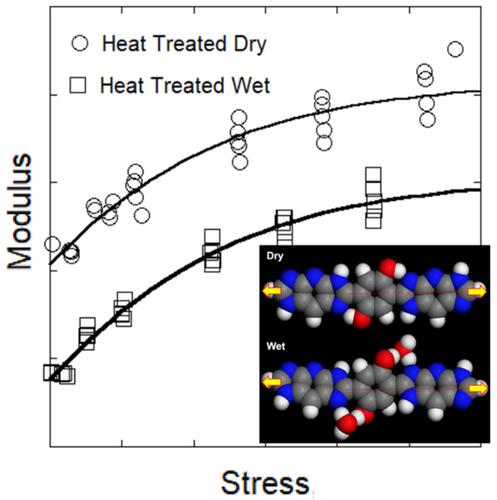当前位置:
X-MOL 学术
›
Polym. Int.
›
论文详情
Our official English website, www.x-mol.net, welcomes your feedback! (Note: you will need to create a separate account there.)
Mechanistic impact of water on polypyridobisimidazole (M5) structure and properties
Polymer International ( IF 3.2 ) Pub Date : 2021-01-19 , DOI: 10.1002/pi.6194 Steven R. Lustig 1 , Steven R. Allen 2, 3 , J. David Londono 4 , Joseph L. Lowery 2, 3
Polymer International ( IF 3.2 ) Pub Date : 2021-01-19 , DOI: 10.1002/pi.6194 Steven R. Lustig 1 , Steven R. Allen 2, 3 , J. David Londono 4 , Joseph L. Lowery 2, 3
Affiliation

|
The hydrophilicity of polypyridobisimidazole challenges the development of M5 fiber for high tensile modulus applications. The material's intractability makes it practically impossible to determine whether the observed loss of stiffness upon water sorption is due to chemical hydrolysis or physical softening or subtle changes in post‐spin structure. This work quantitatively characterizes the mechanisms by which water challenges the technical development of M5 fiber. M5 fibers with different heat and humidity treatments are characterized using two‐dimensional, high‐resolution X‐ray crystallography. Molecular modeling elucidates the detailed structure and identifies where molecular water resides in the M5 crystal. Water interrupts both intermolecular and intramolecular hydrogen bonding as well as changing the larger‐range morphological order within the fiber crystallites. Molecular modeling suggests a specific mechanism as to how water molecules interrupt intramolecular hydrogen bonding. This single mechanism predicts the tensile modulus softening between heat‐treated and subsequently moistened fiber that agrees quantitatively with experimental data. These results support the contention that M5 modulus softening with water ingression can be explained by purely physical conversion of the inherent intrachain molecular hydrogen bonding to intermolecular hydrogen bonding with water, without having to invoke an additional chemical hydrolysis contribution. Quantum molecular dynamics simulations suggest that the polypyridobisimidazole molecule actually exists in two keto–enol tautomeric forms, which interconvert dynamically. Current results indicate that neither form is particularly sensitive to chemical hydrolysis. We currently hypothesize that post‐spinning heat treatment provides a structure that resists chemical hydrolysis. © 2021 Society of Chemical Industry
中文翻译:

水对聚吡啶并双咪唑(M5)结构和性能的机械影响
聚吡啶并双咪唑的亲水性挑战了用于高拉伸模量应用的M5纤维的开发。材料的难处理性使得几乎不可能确定观察到的吸水后的刚度损失是由于化学水解或物理软化还是纺丝后结构的细微变化引起的。这项工作定量地描述了水挑战M5纤维技术发展的机理。使用二维,高分辨率X射线晶体学对经过不同热处理和湿处理的M5纤维进行表征。分子建模阐明了详细的结构,并确定了分子水在M5晶体中的位置。水会中断分子间和分子内的氢键,并改变纤维微晶内较大范围的形态顺序。分子建模提出了关于水分子如何中断分子内氢键的特定机制。这种单一的机制可以预测热处理后的纤维和随后润湿的纤维之间的拉伸模量软化,这与实验数据在数量上是一致的。这些结果支持这样的论点,即可以通过固有的链内分子氢键与水的分子间氢键的纯粹物理转化来解释M5模量随水浸入而软化,而不必引起额外的化学水解作用。量子分子动力学模拟表明,聚吡啶并双咪唑分子实际上以两种酮-烯醇互变异构体形式存在,它们可以动态地相互转化。目前的结果表明,这两种形式对化学水解均不敏感。我们目前假设,纺丝后热处理提供了一种抗化学水解的结构。©2021化工协会
更新日期:2021-01-19
中文翻译:

水对聚吡啶并双咪唑(M5)结构和性能的机械影响
聚吡啶并双咪唑的亲水性挑战了用于高拉伸模量应用的M5纤维的开发。材料的难处理性使得几乎不可能确定观察到的吸水后的刚度损失是由于化学水解或物理软化还是纺丝后结构的细微变化引起的。这项工作定量地描述了水挑战M5纤维技术发展的机理。使用二维,高分辨率X射线晶体学对经过不同热处理和湿处理的M5纤维进行表征。分子建模阐明了详细的结构,并确定了分子水在M5晶体中的位置。水会中断分子间和分子内的氢键,并改变纤维微晶内较大范围的形态顺序。分子建模提出了关于水分子如何中断分子内氢键的特定机制。这种单一的机制可以预测热处理后的纤维和随后润湿的纤维之间的拉伸模量软化,这与实验数据在数量上是一致的。这些结果支持这样的论点,即可以通过固有的链内分子氢键与水的分子间氢键的纯粹物理转化来解释M5模量随水浸入而软化,而不必引起额外的化学水解作用。量子分子动力学模拟表明,聚吡啶并双咪唑分子实际上以两种酮-烯醇互变异构体形式存在,它们可以动态地相互转化。目前的结果表明,这两种形式对化学水解均不敏感。我们目前假设,纺丝后热处理提供了一种抗化学水解的结构。©2021化工协会



























 京公网安备 11010802027423号
京公网安备 11010802027423号